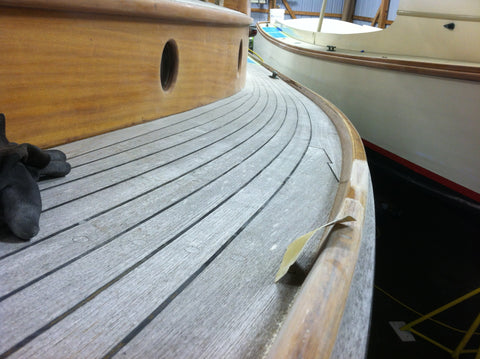Before I started working with Joshua in the studio doing conservation work, I spent over 10 years with some very pretty and very expensive boats. My primary gig was marine varnish, a seasonal process of sanding off last year's gloss, touching up, taping, cleaning, brushing on a coat of varnish, letting it dry, then sanding again and getting even more fussy about cleanliness in preparation for a final coat.

Typically, the cleaning process involved thoroughly vacuuming the boat, washing with water, a wipedown with mineral spirits or alcohol (depending on my mood that day), then hitting everything with a tack cloth before finally beginning to coat. For new boats, this process is repeated 8 or more times over a period of several weeks to build up gloss and protection; for seasonal varnish the typical treatment is 2 coats. But, occasionally, a job required a level of perfection that demanded some pretty extreme measures. These included: tenting off the entire boat in a sealed plastic bubble, soaking down the floor beneath the boat (to absorb any airborne dust), removing all possible sources of noise in the area (no radio, no nearby engines idling, zero tolerance for the presence of any other humans in the zip code, etc.), and wearing a damp Tyvek suit to eliminate the possibility of clothing fibers or a speck of hair from our cat ruining my day. Needless to say, varnishers often come across as stressed out and not at all fun at parties. A disproportionate number of us go prematurely gray.
So imagine my angst, my vexation, my utter bewilderment when I first watched Joshua apply a coat of shellac to a tabletop. He had just sanded the surface lightly, and instead of taking the next hour to clean everything up and kick me out of the studio he simply wiped it off with his nitrile-gloved hand and started brushing on the final coat. What kind of sorcery was this? I was both horrified and fascinated.
Shellac and varnish share some things in common. They are both somewhat naturally sourced - varnish is partially derived from the oil of a tung nut, while shellac is a secretion from the lac bug. I know, kind of weird. Both have been used as traditional finishes for a long time (hundreds or thousands of years). Both are a transparent amber color. Both can give a beautiful glossy finish. But where varnish takes hours to dry, shellac takes seconds (demonstrated well in the Apprenticeship Series: Foundations video chapter on finishes). Where varnish is exceptionally fussy and sensitive to many environmental conditions, shellac is forgiving. Where aging or damaged varnish has to be mechanically removed or stripped (often with heat, chemicals, and/or heavy sanding), shellac is pretty much endlessly resoluble. It's this last trait that continues to amaze me as I work with aged shellac finishes - the way a tired , crackled surface can return to life by reworking the old finish with alcohol still seems almost miraculous. This is why Joshua didn't bother with any more than a cursory dusting before he applied the last coat to that tabletop - the new shellac dissolves the sanding dust, and it becomes part of the finish! A boat's exterior brightwork is essentially sanitized every season, stripped of all patina and returned to high-gloss uniformity. But with shellac, we can save the beautiful coloring that years of use imparts on a piece of furniture while bringing the protective nature of the finish back up to par. Try it. I guarantee you will like it!
We have been counting down the hours until pre-ordering for Issue #2 opens up! The content has come together in a way that has us truly excited. 12:00 am Eastern on November 1st. All pre-orders get free shipping. We hope to hear from you!
-Mike Updegraff


